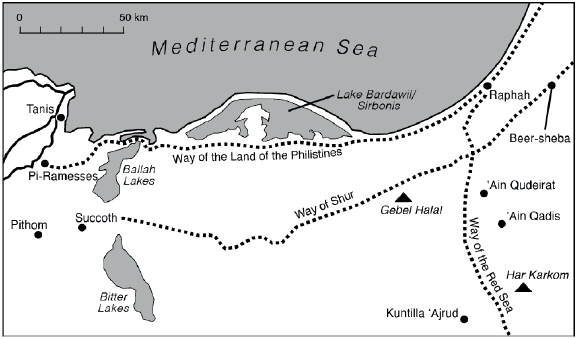The Hebrew Exodus From And Jeremiah’s Eisodus Into Egypt In The Light Of Recent Archaeological And Geological Developments -- By: James K. Hoffmeier
Journal: Tyndale Bulletin
Volume: TYNBUL 72:1 (NA 2021)
Article: The Hebrew Exodus From And Jeremiah’s Eisodus Into Egypt In The Light Of Recent Archaeological And Geological Developments
Author: James K. Hoffmeier
TynBull 72:1 (2021) p. 73
The Hebrew Exodus From And Jeremiah’s Eisodus Into Egypt In The Light Of Recent Archaeological And Geological Developments
Emeritus Professor of Near Eastern Archaeology and Old Testament Studies
Trinity Evangelical Divinity School
[email protected]
Abstract
Egyptian texts mention two bodies of water on Egypt’s eastern frontier with Sinai, š-ḥr and p3 twfy, the latter of which is mentioned in connection with the Exodus (as יַם־סוּף – yam suf), while the former occurs in Jeremiah 2:18. Recent palaeoenvironmental work conducted by the North Sinai Archaeological Project, which was in the field from 1998 to 2008 and directed by the author, has shed new light on these bodies of water and the roles they played in the biblical events involving entering and departing Egypt. The 2019 publication of the geological data now allows one to offer some insights into these ancient lakes. Supplemented by new archaeological discoveries, elements of the routes of both journeys can be elucidated.
Introduction1
A surprising number of biblical narratives contain reports of travel between Canaan/Israel and Egypt. The book of Genesis records several such accounts, including those of Abraham, Hagar, Joseph, and Jacob. Since most of these journeys began in the Negev (or specifically at Beersheba), the route taken was almost certainly ‘the Way of Shur’ (cf. Gen 16:7: דֶּרֶךְ שׁוּר – derek shur)2 which crossed Sinai, running parallel to the Mediterranean coast forty to sixty kilometres to its south, and which then entered Egypt through the Wadi Tumilat (see Figs. 1 and
TynBull 72:1 (2021) p. 74

Figure 1: North Sinai, showing routes out of Egypt. (Adapted by A. D. Riddle from a map by Jessica Hoffmeier Lim.)
3).3 Hence the term ‘inland route’ is sometimes used to describe this little-known track. The Way of Shur is not attested in other texts apart from the Bible. Recent investigations of this road using advanced satellite imagery have helped to clarify sections of the route, which have the potential to lead to ground truthing and the discovery of archaeological sites.4
The route taken by the Ishmaelites with young Joseph wa...
Click here to subscribe
